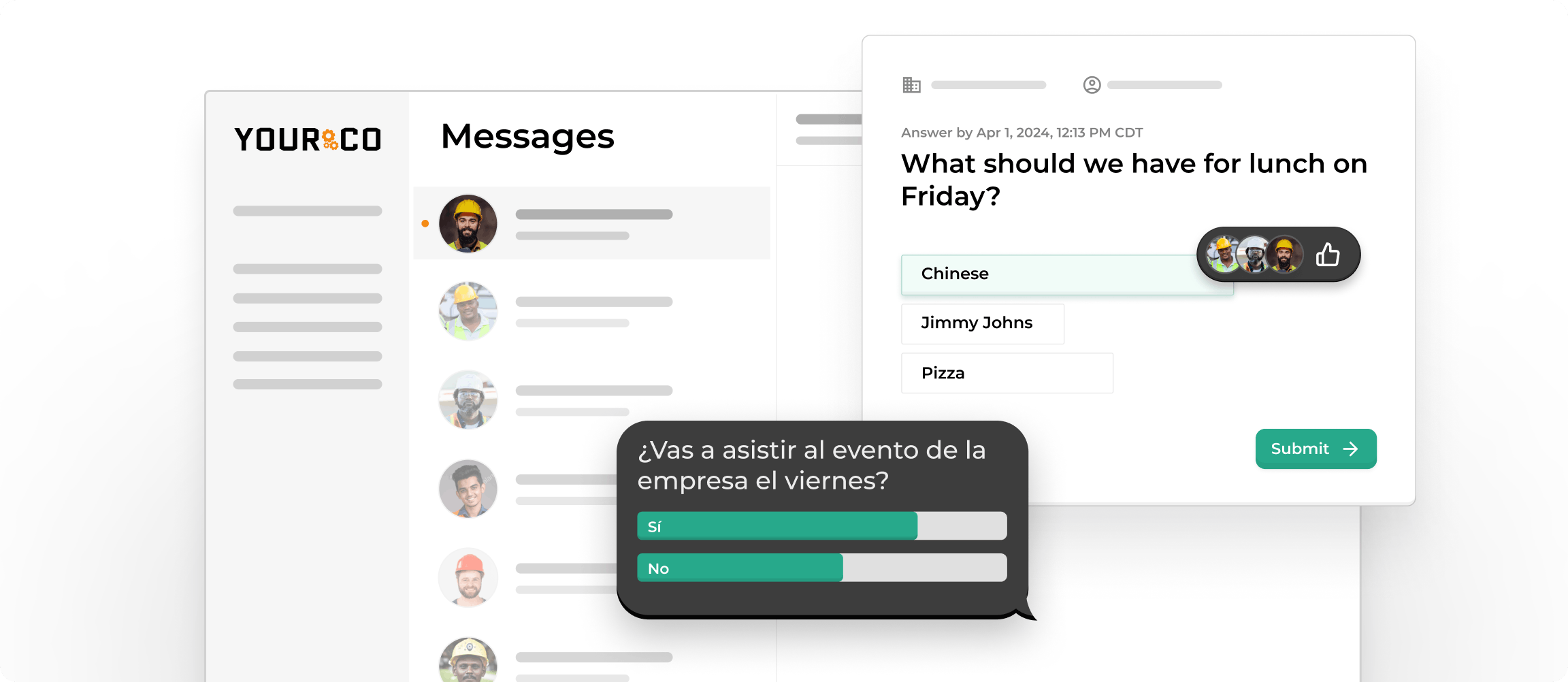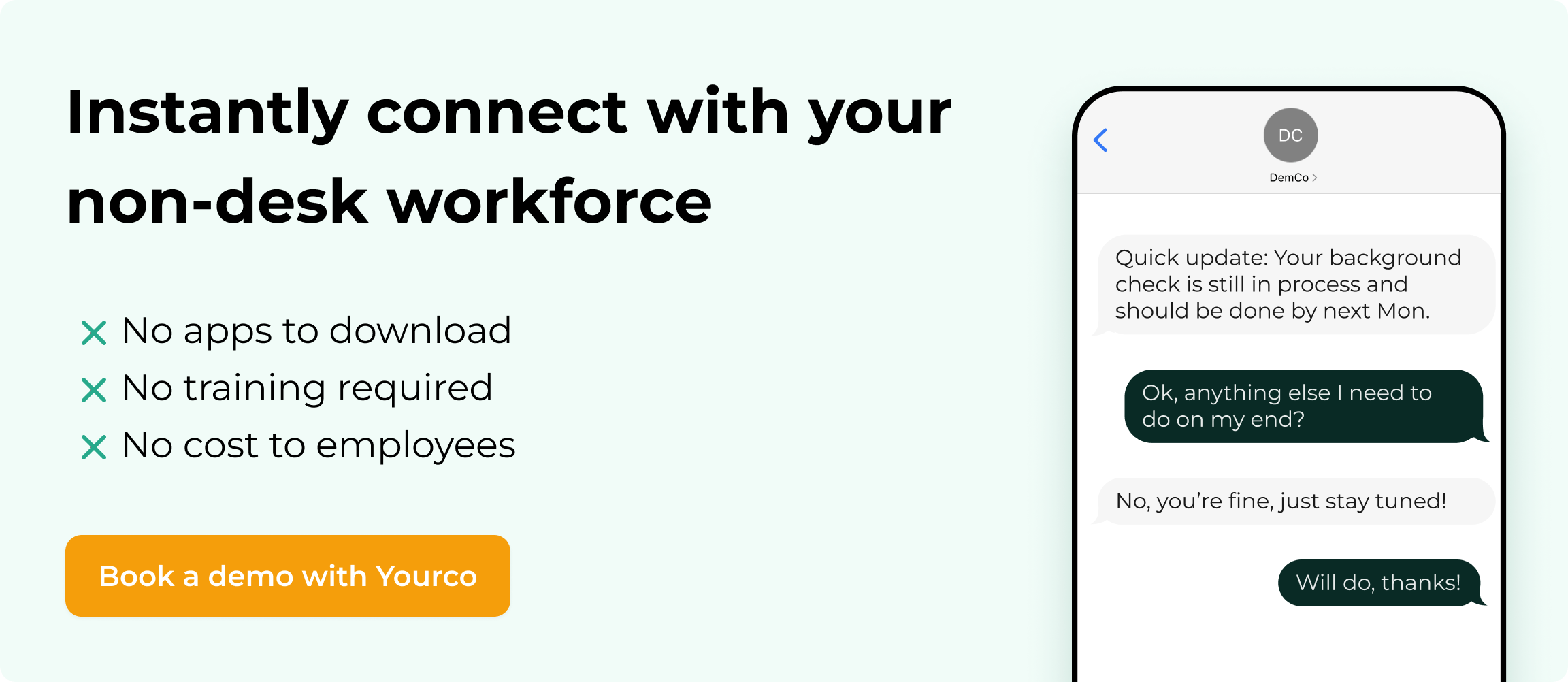How to Create an Employee Engagement Survey for Non-Desk Workers


Non-desk employees are essential to business success, yet they are often the hardest to reach and the quickest to leave. Industries such as manufacturing, construction, retail, and food service face constant turnover, which makes it critical to strengthen connections with frontline teams.
An employee engagement survey is one of the most effective ways to achieve this. When designed for non-desk workers, it captures real insights about their needs and challenges and helps leaders take action that improves retention, communication, and overall performance.
This guide outlines eight steps on how to create an employee engagement survey that works for frontline employees and turns feedback into measurable results.
You don’t have to start from scratch. Download the ready-to-use Employee Engagement Survey Template and begin capturing insights now.
Step 1: Define Clear Objectives When Creating Your Employee Engagement Survey
Start with the end in mind. Before writing survey questions, establish objectives that align with your organization's priorities. Your survey is an enterprise-wide initiative that should connect directly to business outcomes.
While HR typically leads these efforts, bringing in multiple departments creates surveys that address people management issues and broader business objectives. This approach transforms survey insights into improvements that affect everything from customer service to overall performance.
Your objectives should tie directly to company metrics like turnover or productivity. Consider focusing on:
- Evaluating how values apply in daily operations
- Measuring current engagement levels across all locations
- Identifying gaps between stated values and actual culture
- Understanding what drives engagement on your teams
- Creating benchmarks to track progress over time
Ask yourself these questions to focus your approach:
- What specific problem are you trying to solve?
- How will you use the findings?
- Who specifically are you surveying?
- How will you track and share progress?
Learning from previous survey efforts and focusing on areas that will give you actionable insights creates a strategic approach that drives real improvement in your workforce.
Step 2: Select the Right Mix of Questions for Your Employee Engagement Survey
Finding the balance between proven, validated questions and custom ones tailored to your non-desk workforce provides reliable benchmarking data and insights specific to your frontline worker environment.
Mix these question formats for the best results:
- Likert Scale Questions that give you countable data: "On a scale of 1–5, how satisfied are you with the safety measures during your shift?"
- Open-Ended Questions that let employees speak freely: "What one change would make your work environment better?"
When writing for non-desk workers, remember to:
- Use plain language without jargon
- Focus on concrete experiences, not abstract concepts
- Make questions relevant to their daily work lives
- Address real workplace scenarios they encounter
Here are questions that work particularly well in frontline work environments:
- "Do you have all the tools and equipment you need to work safely?"
- "How satisfied are you with communication between management and your team?"
- "What challenges during shift transitions might management not see?"
- "On a scale of 1–5, how physically comfortable is your workspace?"
- "How effectively does your supervisor communicate schedule changes?"
- "What would make you feel more valued in your current role?"
Step 3: Choose Appropriate Question Types and Rating Scales
The question types you select significantly impact your survey results. Selecting wisely ensures you'll get insights you can actually use to improve your workplace.
Question Types That Deliver Results
Mix these effective formats in your survey for comprehensive feedback collection:
- Quantitative questions with rating scales provide measurable data you can track over time and compare across departments or locations. This approach works well for manufacturing or warehouse settings where concrete metrics matter.
- Qualitative questions with open-ended responses reveal deeper patterns and uncover issues specific to your blue-collar workforce that numeric ratings might miss. These responses often highlight practical workplace concerns like tool availability, break time adequacy, or shift scheduling problems.
- Employee lifecycle questions target specific points in the worker journey, from onboarding to training to retention, helping HR teams understand where improvements would have the greatest impact for hourly workers or those in physically demanding roles.
Questions to Avoid
Stay away from problematic question types that could compromise your survey's effectiveness:
- Leading questions nudge respondents toward a certain response, skewing your data and undermining trust.
- Double-barreled questions ask two things but allow only one answer, creating confusion about what employees are responding to.
- Overly complex questions with industry jargon or complicated scenarios frustrate respondents, particularly those who may not use English as their first language.
- Negatively framed questions demotivate participants and create a pessimistic tone.
- Hypothetical scenarios, instead of questions about real workplace situations, produce less reliable data because they don't reflect actual experiences.
- Questions on sensitive topics with no clear purpose risk alienating employees without providing actionable insights.
- Vague questions produce equally vague responses that HR teams can't use to make meaningful changes.
When inviting participation, use neutral language. Avoid saying "be brutally honest" or "show everyone how good we are", as these phrases can skew responses toward either extreme.
Step 4: Implement Effective Communication Strategies for Your Employee Engagement Survey
The difference between high and low survey participation often comes down to how you communicate. Learning how to bridge communication gaps with your workforce can help tailor your approach to reach every worker effectively.
Address Accessibility Barriers
Many non-desk employees struggle with accessibility issues that traditional survey methods don't account for. Factory workers, delivery drivers, and retail staff typically lack access to company computers during their shifts. Maintenance teams and field service workers rarely check email while on job sites. Construction crews and warehouse staff often work in areas with unreliable internet connections.
HR departments supporting these industries need mobile-friendly communication tools that support multiple communication channels and work on mobile devices without requiring data-heavy downloads or complicated setup processes.
Leverage SMS for Direct Engagement
SMS-based communication methods bridge this gap by delivering direct communication that works on any phone without special software or a strong internet connection, making surveys accessible to everyone from assembly line workers to retail associates.
Email and intranets fail to reach non-desk workers effectively. SMS-based communication methods offer a better alternative with dramatically higher open rates — people typically read texts within minutes, not hours or days.
Sending survey links via SMS allows manufacturing, warehouse, and retail workers to participate directly from their phones, improving survey participation and significantly boosting response rates.
HR teams responsible for these frontline workforces find that SMS creates a direct channel to employees who might otherwise remain disconnected from company communications.
The immediacy of text messaging also allows for rapid collection of feedback during or immediately after shifts, capturing in-the-moment perspectives that email-based surveys often miss. This real-time approach helps identify and address concerns before they escalate into larger retention issues.
Step 5: Utilize Mobile-Friendly Survey Methods
When most of your workforce doesn't sit at desks, old-school survey methods simply don't work. Reaching everyone means adopting mobile-friendly approaches and accessible survey formats that work across diverse technical environments.
SMS surveys take advantage of the one tool almost every employee has—a mobile phone. With SMS-based features, you can send links directly to employees and automate reminders, significantly improving participation among non-desk workers. This approach eliminates barriers like forgotten passwords, app downloads, or internet connectivity issues.
QR codes offer another flexible solution that works in physical and digital environments. Print and place these codes throughout your workplace, creating easy access points for employees to complete surveys during breaks or shift changes.
Advanced SMS Survey Capabilities
The right employee texting platform addresses accessibility challenges by providing:
- Text-based survey delivery that reaches non-desk workers on any phone type
- Native SMS polling features for quick pulse surveys
- Integration with comprehensive survey platforms like SurveyMonkey or Google Forms
- Automated messaging for timely communication and follow-ups
- Two-way interaction where employees can respond and send attachments
- Real-time response collection that flows directly into dashboards
- Options for workers without reliable data connections
Meeting employees where they are ensures every voice in your organization is heard, regardless of their work environment or technical setup.
Step 6: Analyze Survey Results Effectively
To get meaningful insights from your surveys, quantify your data using numeric scores or percentages. This approach makes comparisons straightforward and reduces confusion when interpreting survey data across different teams and locations.
Put these analytical strategies to work:
Benchmark Your Results
Compare against relevant standards, including national averages, industry metrics, and your own historical data, to spot improvement areas. Look at how your frontline engagement scores measure up to organizations in manufacturing, retail, or logistics to understand your competitive standing.
Segment Your Data
Break down results by demographics, teams, locations, and shifts to reveal the unique experiences of different workforce segments. This approach helps target action plans when resources are limited. For instance, night shift workers may raise different concerns than day shift employees.
Visualize Your Findings
Use pie charts to show proportions, bar graphs to compare groups, line charts to track changes over time, and call-out graphics to highlight key statistics. Visual formats help frontline managers quickly interpret results and act on them.
Combine Quantitative and Qualitative Analysis
For complex survey data, balance numerical findings with qualitative insights to add context. This ensures you capture both the "what" and the "why" behind engagement levels—critical for understanding the diverse perspectives of a non-desk workforce.
Step 7: Develop and Communicate a Clear Action Plan
The survey is just the beginning. Taking action on survey results shows employees you value their input and are committed to making changes that improve their daily work experience.
When developing your plan, focus on:
- Identifying specific improvement areas based on survey trends
- Prioritizing by urgency and potential impact on retention and productivity
- Setting clear objectives with realistic timelines
- Establishing ways to track progress through follow-up surveys
Employee involvement is essential. People are more likely to participate in surveys when they believe their feedback will lead to actual changes. Invite team members to join action planning sessions to build ownership and commitment.
Communicate Plans to a Dispersed Workforce
When communicating plans to a dispersed workforce:
- Meet employees where they are by integrating communications into their daily workflow through platforms they already use. For non-desk employees, use SMS messages alongside email to ensure everyone gets the information, regardless of their access to computers or company systems.
- Reference previous success by reminding teams of previous survey results and the improvements that followed. This builds trust and demonstrates your commitment to acting on feedback consistently.
- Maintain transparency throughout the process. Explain how you processed feedback, what decisions you made, and when changes will happen. For remote or hybrid teams, consider using automated text message and email survey invitations to keep everyone informed and engaged.
Be specific about improvements. Instead of saying "we'll work on communication," explain "we're implementing weekly SMS updates about schedule changes and safety alerts to keep everyone informed in real-time."
Step 8: Establish a Regular Survey Cadence
Consistency matters. When employees see you regularly asking for their input (and acting on it), they're more likely to stay engaged with the process and trust that their voices matter.
Your survey schedule should align with your business goals and your capacity to implement changes between measurement periods.
Annual Comprehensive Surveys
Provide a solid baseline for manufacturing and distribution companies to track year-over-year changes. They allow enough time to implement substantial updates, like safety protocols or shift structures, between measurement periods. Use them for deeper dives into engagement, satisfaction, and organizational culture.
Quarterly Engagement Surveys
Work well for retail and hospitality operations with seasonal fluctuations. They help HR teams adapt to changing conditions while maintaining consistent measurement. These check-ins catch emerging issues before they affect turnover or productivity, which is especially valuable in high-turnover industries.
Pulse Surveys (Weekly or Monthly)
Capture real-time sentiments from field service teams or frontline healthcare workers, where working conditions change rapidly. These shorter, focused surveys prevent feedback from sitting unaddressed and help managers quickly resolve specific issues such as equipment needs or communication gaps.
SMS-Based Pulse Surveys for Real-Time Insights
For non-desk workers, SMS-based pulse surveys offer unique advantages:
- Immediate delivery to any phone type, including basic cell phones
- 98% open rate compared to 20% email
- Real-time data collection during or immediately after shifts
- Ability to segment by location, shift, or department
- Two-way communication for follow-up questions
- Integration with existing workforce management systems
The priority is establishing a rhythm that allows you to collect data, analyze it, implement changes, and show progress before starting the next survey cycle. For many organizations, an annual comprehensive survey supplemented by quarterly pulse surveys works well.
Whatever schedule you choose, consistency signals to employees that their feedback is part of your ongoing culture, not just a one-time exercise.
Transform Your Survey Strategy with SMS-Based Communication
To create effective surveys, start with clear objectives, select relevant questions, use mobile-friendly methods, analyze results thoroughly, develop action plans, and establish a regular cadence. These steps ensure you capture meaningful feedback from all employees — including those without desk access.
Traditional survey methods often fail to reach non-desk workers effectively. Email surveys get buried in inboxes that frontline employees rarely check. Paper surveys create logistical challenges and delays in data collection.
Mobile-friendly approaches, like Yourco's SMS-based platform, remove these barriers and dramatically improve participation rates among your most hard-to-reach employees across manufacturing, retail, hospitality, construction, and logistics.
The platform delivers surveys directly to workers' phones without requiring downloads, enabling two-way communication that shows employees their voices matter. Employees can respond via simple text message, making participation effortless regardless of their technical skills or device type.
Try Yourco for free today or schedule a demo and see the difference the right workplace communication solution can make in your company.
Frequently Asked Questions
How often should we survey non-desk employees?
Start with an annual comprehensive survey supplemented by quarterly pulse surveys. For non-desk workers, shorter SMS-based pulse surveys (2-3 questions) sent monthly can capture real-time sentiment without survey fatigue. The key is consistency—regular check-ins build trust and show employees their feedback drives actual improvements.
What's the best way to reach employees who don't use email regularly?
SMS-based surveys work best for non-desk employees. Unlike email, text messages have 90-98% open rates and work on any phone type, including flip phones. Employees can respond immediately without needing internet access or remembering passwords. This approach ensures equal participation across your entire workforce.
How can we improve survey response rates among frontline workers?
Focus on accessibility and timing. Send surveys via SMS when employees are most likely to respond—during breaks or shift changes. Keep surveys short (5-7 questions maximum), use plain language, and show how previous feedback led to actual workplace improvements. Automated reminders via text can boost participation without overwhelming employees.
What types of questions work best for manufacturing and warehouse workers?
Use concrete, job-specific questions that relate to daily experiences. Ask about tool availability, safety measures, break time adequacy, and communication with supervisors. Avoid abstract concepts or corporate jargon. Focus on practical workplace issues that directly impact their work environment and job satisfaction.
How do we handle language barriers in diverse workforces?
Use survey platforms like Yourco with automatic translation capabilities. Yourco’s AI-powered translations can convert survey questions and responses into 135+ languages and dialects, ensuring every employee can participate in their preferred language. This eliminates language barriers that often prevent non-English speakers from sharing valuable feedback.
What should we do with survey results to maintain employee trust?
Act quickly on feedback and communicate changes clearly. Use the same SMS channel that delivered surveys to share results and action plans. Be specific about improvements—for example, "Based on your feedback, we're adding two new safety stations" rather than "we're improving safety." Follow up with progress updates to show ongoing commitment to employee concerns.




